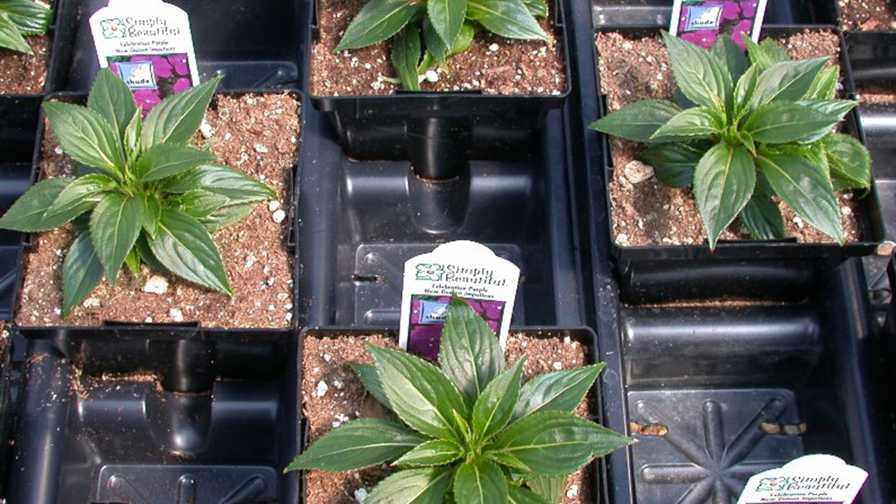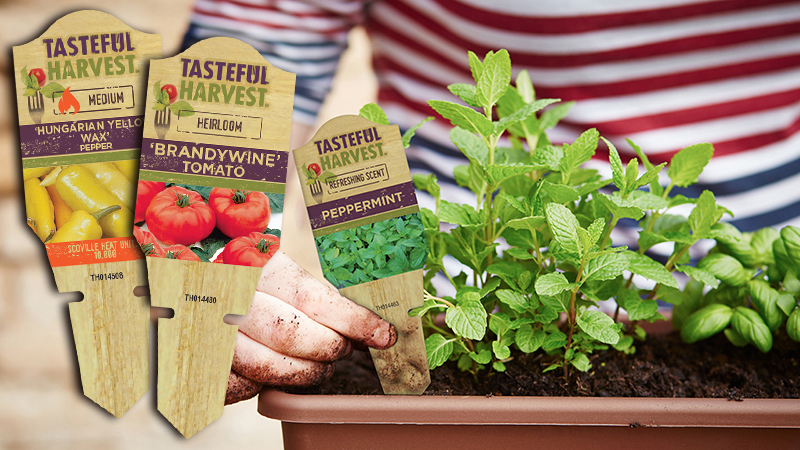Why Moisture Management Matters in Growing Media

As a peat-based growing medium dries out, the surface of the growing medium eventually turns from light brown to tan, as seen in these New Guinea Impatiens. These plants are ready to water. Photo: Premier Tech Horticulture.
One of the most effective ways to make sure your growing media mix is providing a strong path to root development is to monitor moisture. Fortunately, many of today’s leading growing media suppliers are also in the education game. We asked some of them to offer their best advice on how growers can manage moisture in their soil. Here’s what they had to say.
Technique is Critical
According to Ed Bloodnick (Director of Grower Services) and Troy Buechel (Horticulture Specialist, Mid-Atlantic Region) at Premier Tech Horticulture, improper watering can lead to several different crop problems; therefore, proper watering technique is essential for uniform, quality crops.
There are several beliefs among growers about the best watering technique. Some may classify themselves as dry growers, others as wet growers. Either watering technique may work well for an experienced grower. However, there are some guidelines to help improve watering, if water management is a challenge.
For example, knowing when to water is critical. A good indicator is to look at the color of the growing medium surface. As peat-based growing media dries out, the surface turns from light brown to tan, which is a good indication it is time to water. The drying out of bark-based growing media can be difficult to judge from a visual aspect, since color change is not so evident. Coir-based growing media tends to have more rapid surface drying and turns a lighter color long before it is time to water.
For large pots, insert your finger several inches into the container. If the growing medium is relatively dry to slightly moist, it is time to irrigate. For plug trays, press on a cell to see if water drips from the bottom. If not, then it is time to water. Another option is to lift the tray or pot; if it is light weight, then it is time to water.
An important point to remember is that water in growing medium is mostly taken up by plants, and some evaporates from the container’s surface. The larger the plant, the more water it uses; the hotter and/or drier it is, the faster water is taken up by the plant. Therefore, crop type, stage of development, time of day, seasonality, and weather patterns all affect how fast a crop can dry out and determine when to water.
Steps to Success
Charles Bethke, Technical Advisory with PittMoss LLC, says growers are experiencing mounting pressures for efficient and environmentally responsible water management practices.
“In a world where sustainability is socially and economically essential and where legislation is advancing rapidly, growers need to employ products and management practices that foster responsible and efficient production,” says Bethke, who offers several management practices to use as a framework to help in achieving those goals.
- Good water quality: Know your water alkalinity, pH, soluble salt content (EC), and the balance of dissolved minerals.
- Appropriate container size: Containers should be sized to accommodate crop performance and management during development. Containers should not hold excessive quantities of water for extended periods of time.
- Segregate crops to match water consumption: Experienced growers recognize that each crop has an optimal moisture level and grouping crops into water management blocks allows for high performance and plentiful development.
- Timely delivery: Waiting until a crop wilts is often used as the signal for watering, but that causes stunting and alters the absorptivity and water-holding properties of the growing mix. It is a good practice to water on a timely basis and to inject a wetting agent into the water supply.
- Accurate delivery: Be sure to hit your target, which is the growing substrate. Too often, watering systems spray water over a crop, anticipating that some of the water will shed off the foliage and soak into the pot.
- Measured delivery: An abundance of moisture meters and measuring equipment exist to help quantify the amount of water needed and report what is being applied.
- Volume adjustments as crops develop: Attentive growers are constantly changing the quantity and frequency of watering to compensate for the development of the crop.
- Record the applications: A record of water applications is particularly important where management responsibilities can change or rotate. A log helps growers learn what has happened in the past and anticipate what to do in the future.
Correct Problems Early
Wettability is very important for a grower to consider when managing water, as poor wettability means poor water retention, more frequent irrigation, and poor shelf life. According to Daniel Norden, R&D Manager and Senior Technical Specialist at Profile Products, growers who buy premixed media should make sure they are doing first in, first out with themixes they purchase and be wary of loose-fill mixes older than six months. Baled mixes typically will go up to 12 months without wetting issues, and growers should ask how to interpret lot codes from the mix manufacturer so they know how old the mix is they purchased.
“Surfactants are subject to microbial decomposition, so there is a shelf life,” Norden says. ”In my opinion, drenching with a surfactant after potting is less effective than adding surfactant at blending and ensuring proper moisture content. Correct the issue before the mix goes into the pot.”
It’s also important for growers to know the physical properties of the mix they are using.
“Understand terms like total porosity, water-holding capacity, and air space,” Norden says. “Using this information will allow growers to understand how to adjust irrigation practices. Most blenders will have physical property specifications on various substrates already, which can help growers select the right mix for specific crops.”









